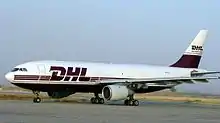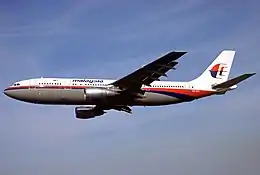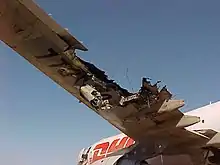2003 Baghdad DHL attempted shootdown incident
On 22 November 2003, shortly after takeoff from Baghdad, Iraq, an Airbus A300B2-200F cargo plane, registered OO-DLL and owned by the Belgian division of European Air Transport (doing business as DHL Express), was struck on the left wing by a surface-to-air missile while on a scheduled flight to Muharraq, Bahrain.[1] Severe wing damage resulted in a fire and complete loss of hydraulic flight control systems. Because outboard left wing fuel tank 1A was full at takeoff, no fuel-air vapour explosion occurred. Liquid jet fuel dropped away as 1A disintegrated. Inboard fuel tank 1 was pierced and leaking.[2]
 OO-DLL, the A300 involved in the accident, photographed in June 2003 | |
| Attempted shootdown | |
|---|---|
| Date | 22 November 2003 |
| Summary | Missile attack leading to loss of hydraulics |
| Site | Baghdad International Airport, Baghdad, Iraq |
| Aircraft | |
| Aircraft type | Airbus A300B4-203F |
| Operator | European Air Transport on behalf of DHL Express |
| Registration | OO-DLL |
| Flight origin | Baghdad International Airport Baghdad, Iraq |
| Destination | Bahrain International Airport Muharraq, Bahrain |
| Occupants | 3 |
| Crew | 3 |
| Fatalities | 0 |
| Survivors | 3 (all) |
Returning to Baghdad, the three-man crew made an injury-free landing of the seriously damaged A300, using differential engine thrust as the only pilot input. This was despite major damage to a wing, total loss of hydraulic control, a faster-than-safe landing speed, and a ground path that veered off the runway surface and onto unprepared ground.[3]
Paris Match reporter Claudine Vernier-Palliez accompanied a disbanded Fedayeen unit on their strike mission against the EAT aircraft.[4]
Sara Daniel, a French weekly newsmagazine journalist, claimed receipt, from an unknown source, of a video that showed Iraqi insurgents (belonging to IAI), faces concealed, firing a missile at the EAT A300.[5][6][7] Daniel was researching a feature about Iraqi resistance groups, but she denied any specific knowledge of the people who carried out the attack, despite being present at the moment of attack.[6]
Aircraft

The aircraft involved was a 24-year old Airbus A300B4-203F. It first flew on 18 October 1979 and was delivered to Malaysia Airlines as a passenger aircraft registered 9M-MHB on 28 December 1979. The aircraft was sold to Carnival Air Lines registered N225KW in June 1995. The plane was converted into cargo configuration in March 1999, and was delivered to the Belgian division of European Air Transport, under whom it operated as DHL, on 22 September 2000.[8]
Background
The aircraft took off from Baghdad International Airport en route to Bahrain International Airport at 06:30 UTC with an experienced crew of three - two Belgians, 38-year-old Captain Éric Gennotte and 29-year-old First Officer Steeve Michielsen, and a Scotsman, 54-year-old flight engineer Mario Rofail.[9] The captain had 3,300 total flight hours, more than half of them logged in the A300. The first officer had 1,275 hours of flight experience and the flight engineer had 13,400 hours of flight experience.[10]
Moments following the strike
| External video | |
|---|---|
To reduce exposure to ground attack, the aircraft was executing a rapid climbout. Around 8,000 ft (2,400 m) altitude, a 9K34 Strela-3 (SA-14 Gremlin) surface-to-air missile struck the rear of the left wing between the engine and the wing tip.[1][11] The warhead damaged trailing-edge surfaces of the wing structure and caused a fire. All three hydraulic systems lost pressure, and flight controls were disabled. The aircraft pitched rapidly up and down in a roller-coaster phugoid, oscillating between a nose-up and a nose-down position.
As in the case of the 1989 United Airlines Flight 232 disaster in the United States, Captain Genotte could only use thrust to modify pitch, speed, and altitude and vary throttles asymmetrically to control yaw and turn the aircraft. Flight engineer Mario Rofail executed a gravity drop to extend the landing gear, a procedure normally accomplished with hydraulic power. Early deployment of the gear was critical to a safe outcome because increased drag helped reduce speed and stabilize the aircraft.
In about 10 minutes of experimentation, the crew learned to manage turns, climbs, and descents. After a meandering trajectory, they executed a right turn and initiated a descent path to Baghdad International Airport.
Final approach and emergency landing

| External video | |
|---|---|
Because of left wing damage and fuel loss, Rofail had to monitor the engine closely; if fuel flow was lost from the left side, he would have to feed fuel from a right tank to maintain thrust. Survival was dependent on accurate power control of each jet engine.
Genotte and Michielsen set up for a final approach to runway 33R. The aircraft drifted to the right of the intended course, so Genotte chose the shorter 33L runway. Visibility was excellent and the pilots managed a controlled descent. They knew, counterintuitively, that they could not reduce the throttles before touchdown without risking the nose or a wing smashing into the ground.[2]
Around 400 ft (120 m) above ground, turbulence upset the aircraft balance and the right wing dipped. With thrust adjustments, the roll was controlled, but the aircraft touched down off the runway centerline. Rofail immediately deployed full reverse thrust, but the aircraft veered off the paved runway. The aircraft ran through rough, soft ground, throwing up a plume of sand and dragging a razor-wire barrier, and halted after about 3,300 ft (1,000 m).[2]
Awards and aftermath
The Honourable Company of Air Pilots jointly honoured all three crewmembers with its Hugh Gordon-Burge Memorial Award.[12] This is awarded to flight crew whose actions contributed outstandingly to saving their aircraft or passengers, or made a significant contribution to future air safety. The annual award is made only if a nomination is considered to be of significant merit.
The Flight Safety Foundation's FSF Professionalism Award in Flight Safety was presented to the crewmembers for their "extraordinary piloting skills in flying their aircraft to a safe landing after a missile strike following takeoff from Baghdad, Iraq".[13]
In May 2006, Captain Éric Genotte, together with Armand Jacob, an Airbus experimental test pilot, gave a presentation to the Toulouse branch of the Royal Aeronautical Society titled "Landing an A300 Successfully Without Flight Controls".
In addition to severe wing and undercarriage damage, both jet engines suffered ruinous abuse by ingesting debris. In November 2004, the aircraft was repaired and re-registered as N1452, then put up for sale, but remained unsold.[1][14] The N1452 registration expired in 2018. The aging aircraft did not fly again and has since been scrapped.
In popular culture
The incident was featured in "Attack over Baghdad", a season-three (2005) episode of the Canadian TV series Mayday[15][16] (called Air Emergency and Air Disasters in the U.S. and Air Crash Investigation in the UK and elsewhere around the world).
See also
Further reading
- Aviation Week and Space Technology, 8 December 2003
References
- Ranter, Harro. "ASN Aircraft accident Airbus A300B4-203F OO-DLL Baghdad International Airport (BGW)". aviation-safety.net. Retrieved 13 June 2017.
- "Great escape". Archived from the original on 23 January 2013. Retrieved 19 July 2012.
- "Air Crash Investigators"
- "Voici le commando qui a touché l'Airbus", Claudine Vernier-Palliez, Paris Match, N° 2845 – 27 Novembre 2003
- "Tape purports to show missile attack on cargo jet". 25 November 2003.
- Daniel, Sara. Voyage to a Stricken Land. Arcade Publishing, 2006, ISBN 1559707852, pg. 77
- Nance, Malcolm (2014). The Terrorists of Iraq: Inside the Strategy and Tactics of the Iraq Insurgency 2003–2014. CRC Press. pp. 168–169. ISBN 978-1498706896.
- "Airframe information N1452 Airbus A300B4-203(F) - Untitled". planespotters.net.
- Elco B. (30 April 2006). "Special planes: OO-DLL hit above Bagdad". European Tribune. Retrieved 9 July 2013.
- "Tribute to Capt Eric Gennotte, to F/O Steeve Michielsen & to Flight Engineer Mario Rofail" (PDF). Yannick Malinge. Archived from the original (PDF) on 25 June 2005. Retrieved 31 March 2018.
- "Pilots relive Iraq missile attack". Flightglobal.com. 9 November 2004.
- The Gordon-Burge Memorial Award Archived 7 April 2019 at the Wayback Machine – THCAP
- FSF Professionalism Award in Flight Safety Archived 21 May 2013 at the Wayback Machine | Flight Safety Foundation
- "Aviation Photo #1909863: Airbus A300B4-203(F) - Untitled". Airliners.net.
- "Attack over Baghdad". Mayday. Season 3. Episode 2. 2005. Discovery Channel Canada / National Geographic Channel.
- DHL Delivery Plane Struck By Air Missile | Mayday | On The Move, retrieved 19 August 2022
External links
- Criminal Occurrence description at the Aviation Safety Network
- Agence France-Presse article about the incident
- ParisMatch article by Claudine Vernier-Palliez, who accompanied the Fedayeen commando unit that attacked the plane.
- Paper by Jacques Rosay
- Australian Government Civil Aviation Safety Authority
- Australian Society of Air Safety Investigators